
Cheerios and childhood – one of those up-in-the-morning start your kid’s day right, right? They’re gluten free, and they lower bloodstream cholesterol – almost like a health food. Except thanks to Monsanto, they’re not healthy, especially if you are a child. Cheerios breakfast cereal and a number of oat-based granolas and snack bars contain dangerous levels of glyphosate.
Over the past several years, the clinical and legal spotlight has been aimed at glyphosate, investigating how it poisons farm workers, landscape applicators, and maybe the general public through water and food exposure. Most recently, the Environmental Working Group (EWG) has done extensive research on glyphosate in foods that could affect human health during early childhood formative years. EWG is the organization that produces the yearly Dirty Dozen Produce list and the Clean Fifteen Produce list. Their findings on Cherios are not reassuring.

From the EWG study report: “The herbicide Roundup, produced by Bayer-Monsanto, was detected in all 21 oat-based cereal and snack products sampled in a new round of testing. All but four products contained levels of glyphosate higher than what EWG scientists consider protective for children’s health. The two highest levels of glyphosate were found in Honey Nut Cheerios Medley Crunch, with 833 parts per billion (or ppb), and Cheerios, with 729 ppb. The EWG children’s health benchmark is 160 ppb.
The EWG, along with nineteen food companies, first tried petitioning the EPA to get regulatory considerations. That process could drag on for years, and besides, the agency has been caught colluding with Monsanto to promote the claim that the chemical is safe. Instead, they are appealing directly to cereal manufacturers like General Mills and Quaker, petitioning them to source their oats from farmers who do not use glyphosate. So far, more than 236,000 people have signed a petition, and the EWG asks you to sign it as well – Get Glyphosate Out Of Our Food.

Two major reports released in late 2018 brought climate disruption to the forefront. For many people who previously had only passing concerns about the climate, the reports are unequivocal how climate disruption is a clear and present danger. The Fourth National Climate Assessment_2018 by the National Oceanographic & Atmospheric Administration, and the United Nations IPCC Special Report on Global Warming of 1.5 °C both reaffirm the science, and both reinforce each other’s conclusion that we have until 2030 to reverse global emissions and warming, before we face runaway climate collapse.
A single report might be easily ignored by deniers of climate trends and the scientific validity behind it, but two reports that present compelling data in detail are hard to dismiss. And now there is a third such report, released in May of this year, that presents a 2050 scenario “with dire implications, absent a fundamental change in human behaviour”.
The Melbourne, Australia based think tank, the Breakthrough National Centre for Climate Restoration, has concluded that the IPCC and the NOAA reports both are too optimistic. The report, Existential Climate Related Security Risks, projects that climate disruption “now represents a near- to mid-term existential threat to human civilization”, with a high liklihood of societal collapse as soon as 2050, if serious mitigation actions aren’t taken in the next decade. The new analysis is written by David Spratt, Breakthrough’s research director, and Ian Dunlop, a former senior executive of Royal Dutch Shell who previously chaired the Australian Coal Association. It is also endorsed by retired Admiral and former Chief of the Australian Defence Force, Chris Barrie.

NBC news explained how the Spratt-Dunlap analysis reached more dire conclusions. “The current climate crisis is larger and more complex than humans have ever dealt with before. Studies such as the UN IPCC report fail to account for the sheer complexity of Earth’s many interlinked geological processes. As such, they fail to adequately predict the scale of the potential consequences.”
The collapse scenario “begins with world governments ignoring the advice of scientists, resulting in a global temperature increase 5.4 F (3 C) by the year 2050. At that point, the world’s ice sheets vanish; brutal droughts kill many of the trees in the Amazon rainforest (removing one of the world’s largest carbon offsets); and the planet plunges into a feedback loop of ever-hotter, ever-deadlier conditions” – Civilization could crumble by 2050 if we don’t stop climate change now. Billions would suffer water scarcity, food production would suffer dramatically worldwide, and nation-states like the US and China would unravel.
Admiral Chris Barrie relates in the study’s introduction “This policy paper looks at the existential climate-related security risk through a scenario set thirty years into the future, painting a disturbing picture of the real possibility that human life on earth may be on the way to extinction, in the most horrible way. A doomsday future is not inevitable! But without immediate drastic action our prospects are poor. We must act collectively. We need strong, determined leadership in government, in business and in our communities to ensure a sustainable future for humankind – Can we think in new ways about the Existential Climate Risks?. The report states that the only way to avoid such a collapse is “akin in scale to the World War II emergency mobilization” focused on rapidly building out a zero-emissions industrial system – ‘Social Breakdown and Outright Chaos’: Civilization Headed for Collapse by 2050, New Climate Report Warns.
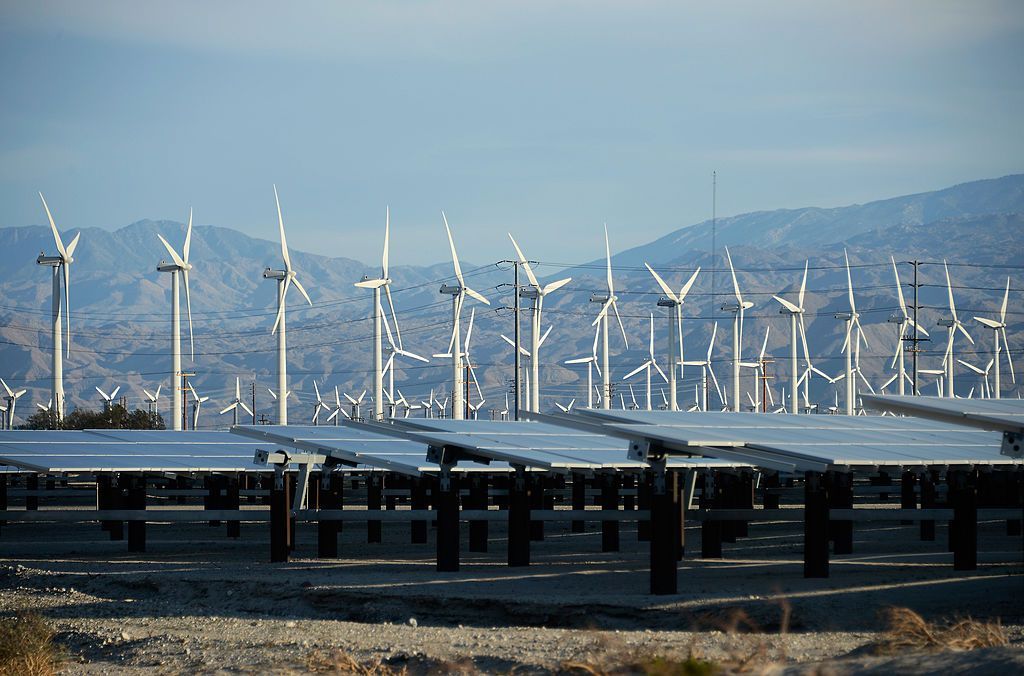
“Imagine a world where 85% of all electricity comes from renewable sources, there are over one billion electric vehicles on the road, and we are on track to preserve a livable climate for our children and future generations. The International Renewable Energy Agency (IRENA) reported this week that such a future is not merely possible by 2050, but thanks to plummeting prices in key clean energy technologies, the cost of saving the climate has dropped dramatically. According to IRENA, the most cost-effective strategy to achieve a ‘climate-safe future’ is an accelerated energy transition to renewables and energy efficiency coupled with electrification of key sectors like transportation.” – Joe Romm, Global economy would save up to $160 trillion by shifting to renewables, electric cars.
The choice is to pay for climate protection by rapidly transitioning to renewables and electrification of everything, or pay increasingly for climate disasters. The National Oceanographic & Atmospheric Administration (NOAA) cost figures for 2017 climate disasters was $306 billion, a record high. NOAA said that since 1980, the total costs for climate disasters has been $150 trillion – 2017 Weather and Climate Disasters Cost U.S. Record $306 Billion. By comparison, the IRENA report projects that over the next 30 years, a Renewable Energy Roadmap (REmap) scenario “would save the global economy up to $160 trillion cumulatively”. IRENA reports that “every dollar spent on energy transition would pay off up to seven times”. At the same time, the REmap would achieve more than 90% of emissions reductions needed to keep warming below 2 degrees Celsius, by reversing the emissions curve 70% – Global energy transformation: A roadmap to 2050 (2019 edition).
Of course, the transition to a renewable energy economy should have begun 30 years ago, as folks like Amory Lovins, Donella Meadows, M. King Hubbert, and James Hansen had championed. But since we are in the current bind we are, Yes! Magazine has described a three phase transition that can make great strides within ten years, and almost a complete transition by 2050, while simultaneously reducing atmospheric carbon with each passing year. The first phase takes on the easy stuff, like solar and wind power for electricity instead of coal, rooftop solar with battery storage, walking and bicycling and transit, and electric vehicles (EVs). Add to that things that hadn’t emerged at the time of the 2016 Yes! article, such as the rapid development of EVs as battery storage for utilities, as well as utility scale battery banks to replace peak load generation by natural gas. And a move to more organic agriculture could significantly reduce much the 20% of emissions from petro-chemical fertilizers and pesticides, while sequestering enormous amounts of atmospheric carbon in topsoil. For some reason, the article overlooks the even larger potential of tree planting to capture atmospheric carbon.
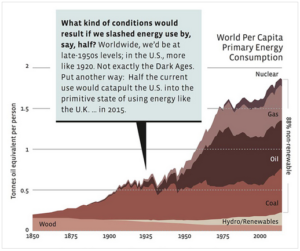
Phase two tackles the more difficult stuff, like electrifying heavy transport by truck and rail and transit, converting to sail-powered ocean ships, and deglobalization of manufacturing to reduce the need for shipping. There are significant challenges in the manufacturing sector, though much of it already runs on electricity. Considerable effort will be needed to replace fossil fuel feedstocks for plastics and other petrochemicals, such as the emerging bio-based plastics. Mining and metals smelting pretty much require fossil fuels, so a strategy may be to reduce their need by “cradle-to-cradle” reuse and recycling programs.
And phase three addresses the really hard stuff. The second most common building material is concrete, which requires the high heat of fossil fuels to cook the portland cement. To convert to production by concentrating solar thermal or solar-derived hydrogen would require completely redesigning the process. The most difficult aspect of eliminating fossil fuels from agriculture is in the realm of mechanized field traction – plowing, discing, combining. Abandoning huge industrial farms in favor of smaller, more labor intensive organic farms will likely meet with resistance unless labor and pay equity are guarantied. The use of rare earth minerals and high heat processing for electronics and communications is a knotty problem, for which the best solution might be to make very durable and readily repaired products. And finding a light weight, energy dense power source for air transport is barely on the drawing boards – 100% Renewable Energy: What We Can Do in 10 Years – Yes! Magazine.
A sobering take-away lesson from the Yes! article is, “One way or another, the energy transition will represent an enormous societal shift. During past shifts, there were winners and losers. In the current instance, if we don’t pay great attention to equity issues, it is entirely possible that only the rich will have access to renewable energy”.
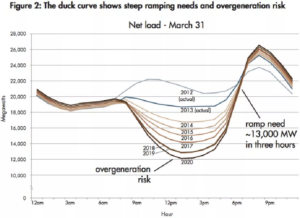
To achieve the practical goals listed in the Yes! article, a renewable energy future will need to electrify everything. The common perception from the coal electricity era has been that electricity is inherently dirty, and to be minimized. However, it’s possible, and it’s getting progressively more feasible to get electricity down to zero carbon through wind, solar, hydro, and geothermal (some falsely claim nuclear too – read the myth here – There is no such thing as a zero or near-zero-emission nuclear power plant). The same cannot yet be said of combustion fuels, even of biofuels that take an almost equivalent amount of fossil fuels to grow and process. Much of the research to electrify everything is focused on the electric grid – how to supply it with carbon free energy, and how to balance the ever-fluctuating solar and wind supply with the ever fluctuating user demand – as represented by the “duck curve energy demand cycle”. We won’t get into the details here, but the reading is fascinating at – The key to tackling climate change: electrify everything, and What Would the ‘Electrification of Everything’ Look Like in America?.

For anyone paying attention, and who takes the scientific data seriously, it’s understood that the surviveability of humans and up to 50% of other species is in peril. The threat is not just climate disruption. It’s just that the harsh and widespread impact of climate disruption is tangible in a way that tends to be convincing. Other not-so-obvious ways that threaten the planet’s livability are what Swedish environmental science professor, Johan Rockstrom, calls the Nine Planetary Boundaries. They include: lost biodiversity as species become extinct, deforestation and other land use changes, ocean acidification, freshwater depletion, and dumping of chemical, radioactive, and plastic pollutants into the environment, to name a few – Earth is halfway to being inhospitable to life – Planetary boundaries. The impact of these tend to be incremental and scatter-site, and not as apparent as extreme climate events until some cumulative threshold is passed, and disaster strikes. Even then, the cause and effect is often difficult to connect.
Pollution dumping as a breach of an Earth Boundary holds a unique place among the various boundaries. Chemicals, radioactivity, and plastics are all products of the energy sector, which for 150 years has been extracting non-renewable fossil and nuclear fuels from the Earth. The pollutants that accompany this extractive onslaught are the consequence of our ravenous energy appetite. And an unrestrained fossil energy appetite is the primary driver of transgressions against all the other Earth Boundaries – climate disruption from greenhouse gases, deforestation from energy extraction, ocean acidification from greenhouse gases, freshwater depletion from energy extraction and chemical pollutants, land and waterways pollution from synthetic farm chemicals, and more. It all starts with non-renewable energy extraction. That’s the underlying cause, and everything else is a consequence. Non-renewable energy is THE problem.

People and groups who have been confronting the range of issues we are discussing have usually grappled with one narrow aspect at a time, because that’s at a scale they can manage. But they often fail to see the forest for the trees – that energy is at the root of their local issue. Multiple groups attacking distinct angles of an issue can work well, as in “death by 100 cuts”, so long as they all view it in the context of non-renewable energy being the ultimate problem. Now, if this editor’s read of history is correct, mass protest groups first looked beyond a local issue and cited global fossil energy as the problem when First Nations People in both Canada and the U.S. tackled pipelines and tarsands mining. Tribes and coalitions such as Silent No More and Water Protectors said the solution to all energy justice issues was to “Keep it (fossil energy) in the ground”. If we don’t burn fossil fuels, we won’t suffer the consequences.
As a strategy, “keeping it in the ground” stops ecological and social damage on many fronts simultaneously. With no fossil fuel use, the land, water, and air, and vulnerable populations as well will all be protected – done! The idea is captivating, and has become a rallying cry. For more than a decade, analysts have run at least 40 different computer models to show that 80% or more of fossil fuel reserves must remain in the ground if we hope to regain a livable atmosphere. Bill McKibben explained that of the 2,795 gigatons of carbon in the proven coal and oil and gas reserves, all must remain untapped except for 565 gigatons to keep the planet below 2°C warming (and we now know that 1.5°C is the safe level) – Global Warming’s Terrifying New Math.

So here’s the conundrum. Stopping the social and ecological damage of fossil (and nuclear) energy is one half of the equation. By doing that, it should be noted that the equation’s other half will also stop most of modern society’s functions. In rough numbers, non-renewable energy currently supports: 95% of electricity supply, 95% of transportation fuels, 95% of building heating, 80% of food production from synthetic inputs, 75% of consumer products based on plastics (including the computer you’re reading this on), and 50% of building materials based on oil-derived adhesives, coatings and finishes. All this goes out the window with non-renewable energy. Obviously, to curtail society’s non-renewable energy use so drastically will require two alternative tactics: generation of non-fossil-derived materials and fuels, but even more so, adoption of more frugal lifestyles. Finding substitutes to completely replace the non-renewable inputs of modern society is a tall order, especially before the climate target dates at mid-century. For example, renewable electricity is a particularly daunting challenge – The Global Energy System Is Becoming More Electric, But Not Fast Enough, and At this rate, it’s going to take nearly 400 years to transform the energy system.

As far as is known, the other eight Earth Boundaries have no target dates like climate warming, other than “urgent”. According to the National Academy of Sciences, the human appropriation of net primary production (HANPP) of the Earth is above 25%, and trending to 30% by mid-century. HANPP measures the units of carbon per year expropriated by humans from biomass, including crops, timber, livestock forages, human caused fires, and conversion of forest to cropland or urbanization. The more taken by humans, the less available for other species – Global human appropriation of net primary production doubled in the 20th century. The Global Footprint Network noted that 1 August 2018 was this year’s Earth Overshoot Day, when humanity’s total annual demand on nature exceeded what Earth’s ecosystems can regenerate in that year – Earth Overshoot Day 2018 is August 1, the earliest date since readings done. And a report by twenty two scientist entitled the “Global Environment Outlook” from the United Nations Environmental Program (UNEP) noted that once 50-90% of an ecosystem is altered, it risks imminent collapse. On a global scale they indicated that 43% of the world’s terrestrial ecosystems have been converted to agriculture or urban use, and unless patterns of human consumption are greatly reduced, by 2025 half of the world’s land surface will have been altered. Lead author Anthony Barnosky warned “We want to stay away from that 50%” – Scientists: if we don’t act now we’re screwed.
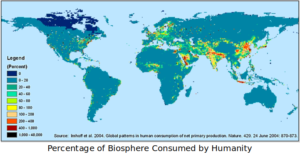
Whatever way you cut it, human impacts on the planet, climate and otherwise, are stressing the ecosphere to the limit. Curtailing fossil and nuclear energy is imperative to bring the Earth back from the brink, but will have far reaching implications for human societies. A look at climate disruption and coming to grips through some realistic scenarios is explored in this in-depth article – Real ambition on global warming: what it would look like. It generally applies to the other Earth Boundaries as well. Whatever scenario is preferred, it will need to entail a range of tactics, all pursued simultaneously, to reach zero carbon or better yet negative carbon. By our assessment, the following are the minimum key goals of any prescription to lower the fever of the planet.
-
Keep non-renewable fuels in the ground: More than 80% of fossil fuel reserves must remain in the ground if we hope to regain a livable atmosphere – Global Warming’s Terrifying New Math..
-
Invest in 100% renewable electricity: The annual U.S. $20billion subsidies of fossil fuels and the hundreds of $billions invested by global banks in fossil fuels must shift entirely to renewable energy – World’s Biggest Banks Are Driving Climate Change, Pumping Billions Into Extreme Fossil Fuels.
-
Electrify all end uses: With some exceptions like heavy transport and blast furnaces, applications of space heating, light transport, motor drive, and industrial boilers and process heating are prime targets for electrification – Enter the electrification of everything.
-
Enhance and utilize ecosystem services: Ecosystem services support humans, like carbon sequestration, pollination, and water purification. Compromised systems mean that human labor and technology must perform the functions at our expense – Ecosystem Services.
-
Drawdown CO2: Excess CO2 must be removed from the atmosphere to regulate the Earth’s temperatures at a safe level. Drawdown can be facilitated by a full range of solutions, both technical and natural – Drawdown Solutions.
-
Polluter pays: One way the rich get rich is by privatizing profits while socializing the costs, such as not paying to dump pollution, forcing society to either pay for clean-up or suffer illness. The Polluter Pays Principle is recognized by law, but not applied consistently nation to nation – What is the polluter pays principle?.
-
Forest protection and reforestation: Reforestation is the most effective “carbon negative” solution, whereas carbon capture and sequestration is expensive and unproven – Nature could suck up 21 percent of our greenhouse emissions (with a little help).
-
Indigenous Peoples’ Land Management: Indigenous land management conserves biodiversity, maintains ecosystems services, safeguards gifting cultures and traditional ways of life, and resists against deforestation and mineral, oil, and gas extraction – Indigenous Peoples’ Land Management.
-
Reduced meat diet: The UN Food and Agriculture Organization reported that 17.4% of greenhouse gases (GHG) are produced by livestock. Cattle ranching accounts for 80% of Amazon deforestation, and 65% of U.S. farm manure is from CAFOs – Without changing human diets, it’s impossible to halt global warming.
-
Frugal lifestyle at northern European consumption rates: The U.S. 5% of global population uses 25% of the world’s fossil fuels. Per capita emissions in the U.S. are three times as high as in Denmark. Frugality is pocketbook and planet friendly – Capital Accumulation and Opting Out of the Consumerist Machine.
-
Raise soil organic matter to 10%: Fertile soils have up to 10% carbon, but chemical farming reduces that to near 2%. Adding carbon back through no-till cover crops, perennial cropping, and biochar will sequester CO2 as well as recreate fertile soils and enable organic agriculture – Soil as Carbon Storehouse: New Weapon in Climate Fight?.
-
Educate girls: Women with more years of education have fewer and healthier children. This is one of the most powerful levers to cut emissions by curbing population growth – Educating Girls.
-
Population reduction to 2 billion humans: Per capita conservation of energy and resources can reduce climate emissions, but only if population doesn’t outpace frugality. Continued exponential population growth is a dead end on a finite planet – Too Many People, Too Much Consumption.

It’s National Drive Electric Week – September 8-16, 2018. The Sustainability Action Network is presenting the Lawrence Electric Vehicles Showcase on Saturday, 15 September, as one of 300 similar events around the country. It will take place from 1:00-4:00pm in The Merc Co+op parking lot, 901 Iowa St., Lawrence KS 66044.
Though not a panacea, electric vehicles (EVs) can significantly reduce the fossil energy use by cars, trucks, and buses. The U.S. transportation sector now produces more climate warming emissions than does the electric generation sector. Plug-in EVs produce no carbon tailpipe emissions when charged with renewable energy. And because an EV is lighter than a fossil fueled car, and electric motors are more energy efficient than internal combustion engines, an EV has a lower carbon footprint in general, even when charged by coal fired electricity. EVs get 100mpg equivalent or better, and the driving range is from 100 miles to 315 miles.
It will be an exciting lineup of EVs at the Lawrence Showcase:
- 3 Nissan LEAFs
- 5 Tesla Model S, 2 Tesla Model X, 2 Tesla Model 3
- 1 Toyota Prius Prime
- 2 Chevrolet Bolts, 2 Chevrolet Volts
- 1 Honda Clarity
- 5 electric bicycles
You will be able to see these vehicles in the Merc Co+op parking lot, talk with their owners, and learn the advantages of driving an EV. We’ll have electric bicycles too. Electric cars are a great improvement over fossil cars, but E-bicycles are the gold standard, using but a fraction of a percent of energy used by any motor vehicle. A 4000lb car requires up to 60 Kilowatts (60,000 Watts) of electricity per hour, and consumes about ten times the electricity used by a home. A bicyclist pedaling uses only 150 Watts to go 20mph, and slightly more if electric pedal assisted.
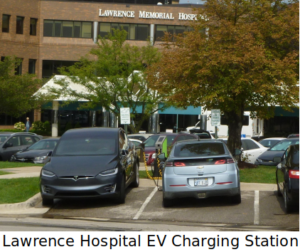
Two City Commissioners will be at the showcase with their electric vehicles. Also, a Proclamation by the Lawrence Mayor for Drive Electric Day will be read at the Lawrence City Commission meeting at City hall, on Tuesday, 11 September, at 5:45pm. Furthermore, at the same meeting, the Commission will approve an electric vehicle charging station at 733 New Hampshire St., the first one downtown. This will be the sixth in Lawrence (The Merc Co+op will install the seventh soon!).
We’re grateful for our co-sponsors, the Sierra Club/Wakarusa Group and The Merc Co+op, and support from the Kansas Cycling Association. This local event is one of 300 community events being celebrated across the country during National Drive Electric Week. Check our event page at – Lawrence Electric Vehicle Showcase, and Lawrence Electric Vehicle Showcase – Facebook.


















Recent Comments